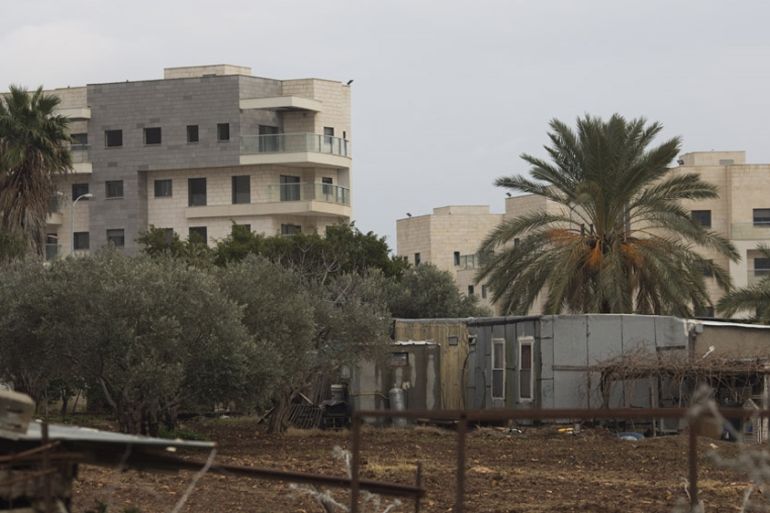Israel ‘closing in’ on Palestinian village in Galilee
An Israeli development project threatens to swallow what remains of the Palestinian village of Ramya.

Ramya, Galilee – Abu Nazeeh’s home is a simple, one-floor, wood-covered structure with a corrugated iron roof. Amid the surrounding luxury apartment blocks built of pink-hued stone, it feels impermanent.
Inside, however, the overstuffed couches and kitschy knick-knacks conjure feelings of stability – as does Abu Nazeeh’s resolution to make this a home, despite the continuing threat of eviction.
Keep reading
list of 4 itemsRussia-Ukraine war: List of key events, day 791
US top diplomat Blinken calls for ‘level playing field’ for firms in China
Why are nations racing to buy weapons?
To Israeli authorities, this home, located in the village of Ramya in northern Israel, should not exist. The Karmiel municipality does not provide any services here, and to get electricity, some residents buy their own generators and illegally connect to the city’s power lines.
The Israeli government wants Abu Nazeeh, 50, a construction worker, and approximately 150 other residents of Ramya to leave.
INTERACTIVE: Building the occupation
Ramya lies inside the Israeli city of Karmiel, founded on lands expropriated in the 1950s from several Palestinian villages, including Ramya. The Karmiel municipality plans to build more apartment blocks on Ramya’s lands, swallowing what remains and forcing Palestinian villagers to relocate.
They are choking and closing in on us. We've been in court for 40 years; it's a very slow struggle. Every time they take small bits and pieces.
“They are choking and closing in on us,” Abu Nazeeh told Al Jazeera. “We’ve been in court for 40 years; it’s a very slow struggle. Every time, they take small bits and pieces.”
Last November, Israel’s High Court refused to hear an appeal filed by Ramya’s residents, ruling that they must sign a deal to relocate and accept the manner in which the proposed land was divided in 1995, or else be evicted by force.
Residents are living on a thin edge as a deadline to sign a deal was extended for another month this week, after which they would be given a year to move out.
Residents say the land being offered in the deal is only a fraction of what they originally owned.
“Psychologically, the people of Ramya will not be able to sign this agreement without the solution that they need,” the lawyer, who is filing a new appeal on behalf of Ramya’s younger residents, told Al Jazeera.
A spokesperson for the Israel Land Administration (ILA), the government body in charge of administering public lands (93 percent of land in Israel is public), told Al Jazeera that they “expect the court verdict to be fulfilled”, noting that residents “will not be given additional land blocks”.
The ILA would not comment on the proposed use of the land, but residents say it is being seized for a multimillion-shekel development project. A spokesperson for the Karmiel municipality declined Al Jazeera’s request for comment.
The government has offered to relocate residents to a new site – what residents call a “segregated neighbourhood” – at the city’s edge.
“It’s a show,” Ramya resident Salah Sawaed told Al Jazeera, as he strolled down a dead-end street in the proposed site. “I knew every stone in this area. Down there, there was a well that has been destroyed. It’s a humiliation you cannot express in words.”
The Israeli government initially expropriated Ramya’s land in 1976 as part of a mass confiscation in the Galilee area, that triggered demonstrations and strikes throughout Palestinian towns and villages.
When six demonstrators were killed during a march, the day of their death became known as Land Day, which is still marked by Palestinians around the world.
About 1.8 million Palestinians, approximately a quarter of the Israeli population, live in Israel and carry Israeli citizenship, but since 1948, Israel has passed more than 50 laws that directly or indirectly discriminate against them.
READ MORE: Bulldozers flatten Bedouin village 49 times
Karmiel was built as part of a governmental plan to encourage Jewish settlement in the Galilee, a region where most Palestinian towns and villages in Israel are located.
|
|
The plan included financial incentives and the development of industrial areas and infrastructure.
“Plans to Judaise Galilee were later translated into plans to build Jewish communities and towns, most of them built in the late 70s and early 80s. These were handled through admission committees, which de-facto excluded Arabs,” Suhad Bishara, a lawyer specialising in land and planning with the rights group Adalah, told Al Jazeera. Admission committees determined who could reside in communities of fewer than 500 households.
Two cities, Karmiel and Nazareth Illit (upper Nazareth) were established as part of this plan, stifling the growth of Palestinian villages. Neither Karmiel nor Nazareth Illit have Arab schools, and children are sent to study in the nearest Palestinian town.
Sawaed maintains that, even if there is no law to prevent him from buying a home in Karmiel, in practice it would be difficult.
“Renting is not a problem, but buying is a problem. You have to find someone to buy on your behalf, through a back way,” he said. “They don’t sell to Arabs.”